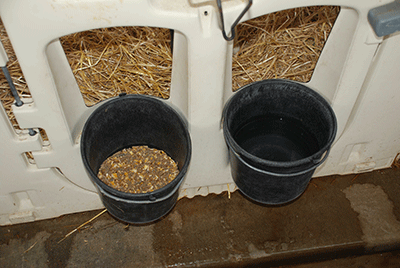
 Feeding calves the correct amount of grain can be a challenge. Many calf raisers work with hundreds of calves that may vary in age from 1 day to 12 weeks old; all of which have different nutritional needs.
Feeding calves the correct amount of grain can be a challenge. Many calf raisers work with hundreds of calves that may vary in age from 1 day to 12 weeks old; all of which have different nutritional needs.One challenge with managing large calf groups of varying age and size is that they don't all eat the same amount of calf starter. There is a delicate balance between avoiding overfeeding calf starter to younger calves while not letting older calves run out. That's according to Christie Underwood, a calf and heifer specialist with Purina Animal Nutrition in Texas.

It is important for calf feeders to be aware of how much calves eat at varying stages of life to avoid wasting feed and to help improve calf growth performance. According to Underwood, keeping calf starter and water fresh and readily available are vital to maintaining optimal calf growth.
The young calf (first two weeks of life)
Within the first two weeks of life, calves often consume very little calf starter and are more dependent upon liquid nutrition.
 "One common mistake I see on-farm is that calf feeders tend to offer a large amount of feed to young calves," notes Underwood. Ideally calf starter should be changed every day and old feed should be discarded. Unfortunately, this doesn't always happen and uneaten calf starter goes to waste.
"One common mistake I see on-farm is that calf feeders tend to offer a large amount of feed to young calves," notes Underwood. Ideally calf starter should be changed every day and old feed should be discarded. Unfortunately, this doesn't always happen and uneaten calf starter goes to waste.This may also interfere with calf starter consumption because the starter becomes stale. Stale calf starter may look ok to eat, but is no longer palatable. To put it into perspective, Underwood compares stale feed to a cracker that has been left out. "It may look just like the crackers left in the package, but it will not taste good after a day or two," she says.
Three to four weeks of age
According to Underwood, by the time calves reach three to four weeks old, noticeable increases in calf starter intake should be seen. During this timeframe, it is important that employees monitor feed intake closely, as this increase can often go unnoticed and calf growth could be hindered due to inadequate nutrition.
Calf feeders should pay attention to how much feed is left. If calves are finishing their feed on a regular basis, then their daily allotment should be increased.
Weaning (four to eight weeks)
By the time calves reach weaning age, they should be consuming higher amounts of calf starter. Underwood points out that calf starter intake may even double. Employees need to be aware of potential spikes in consumption and be ready to meet calves' increased appetite.
Grain-only phase (eight to 12 weeks)
After calves are weaned, they rely on complete feeds as their sole source of nutrition.
"Some operations that I work with leave calves in a hutch or pen for up to 12 weeks of age," says Underwood. Once calves reach 12 weeks old, these calf raisers begin introducing a calf grower feed so that their calves can transition more easily to a diet higher in fiber.
As calves continue to grow, starter consumption increases significantly; it is important to not limit intake at this stage of development. It is also important not to let calves go periods of time without starter. Some animals may slug feed when feed does become available and this could lead to bloat.
To help achieve optimal growth, calf starter should always be fresh, dry and readily available. By working closely with your calf feeders, over-consumption and under-consumption of feed can be prevented, says Underwood. Doing so can allow your calves to get the most out of the nutrients you provide them so that they are able to keep growing and become productive cows with greater profit potential.
For more information, contact Christie Underwood at (806) 640-8045, email CMUnderwood@landolakes.com or visit www.amplicalf.com.
Purina Animal Nutrition LLC is a national organization serving producers, animal owners and their families through more than 4,700 local cooperatives, independent dealers and other large retailers across the United States. Driven by an uncompromising commitment to animal excellence, Purina Animal Nutrition is an industry innovator, offering America's leading brands of complete feeds, supplements, premixes, ingredients and specialty technologies for the livestock and lifestyle animal markets. Headquartered in Shoreview, Minn., Purina Animal Nutrition LLC is a wholly owned subsidiary of Land O'Lakes, Inc.
9.9.2013